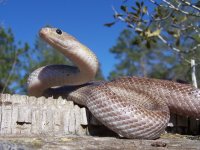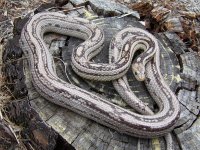Susan
Go Ahead, Make My Day!
It sounds like the book you're reading is possibly an "old" one. In the very least, it's a bit inaccurate. The list of cornsnake species is the first mistake. There are a couple of sub-species, and even those will vary as to the source and when the information has been published. But Okeetee and Miami phase are simply selectively bred "looks" of normal (wild-type) cornsnake coloration...not seperate sub-species, let alone seperate species!gwb8568 said:that would be awesome......i have loves book along with two other "corn/rat snake" books and read them all. sometimes things make sense, but as soon as another thread starts and the discussion get going......... :sidestep: i'm out.
i never followed biology through high school or college, and not being conceted, i was smart enough to get an academic scholarship along with an athletic. but when the topic turns to genes/traits/hets/homos/hypos/etc........ :sidestep: there i go again. all i know of as right now after being here for 8 months is that: amel lacks the blacks and anery lacks the reds. and i even have to picture my anery when i think it to my self to make sure i am not talking about the other.
and lastly.......one more thing that is very confusing is this from my "Corn Snakes and other Rat Snakes" book by Bartlett. This is what is stated in shorter terms: Corn Snake species....normal, okeetee, miami, rosy rat and kisatchie. Designer Corn Snakes........axanthic, amelanistic, blood-red, amelanistic (white albino), sunglow, candy cane, snow, ghost, blizzard, hypomelanistic, christmas, butter, pepper(pewter), lavender, amber and caramel. Pattern Mutations......motley, striped, aztec, milk snake phase, creamsicle and candy cane. now how in the hell can a candy cane be a "color" or "morph" AND also be a pattern....... :shrugs: now i don't understand all of the above and even after reading it over and over and over i still have some learning to do, but that last one throws me. i can deal with not knowing what you need to get a certain type snake (ultramel, granite, etc.) but i have yet to find a way to make it "stick". now granted next year i will be breeding for my first time (with pcar/paul) so once we mix up some parents and i get to see the results, it might make more sense to me then. but in the mean time, does anyone have like a 3rd or 4th grade level book on genetics.
sorry to "hijack" the thread as i was going to start one on my own, but with the replies that are sure to come after this post and the title being "hets" i thought that this might end up being a good thread for everybody who would like to learn. thanks again susan. :cheers:
And as for the pattern mutations, milksnake phase and candycane are again, selectively bred looks that can affect the pattern, especially the milksnake phase, but they are not created by a recessive gene like motley and diffusion is. Zigzag/aztec is a pattern mutation, but exactly what and how many genes are invloved with the look has yet to be determined. And as for creamsicle...that is a hybrid, not a cornsnake morph. A creamsicle is a cross between a cornsnake, (Pantherophis guttata - formerly Elaphe guttata guttata) and a Great Plains rat snake (aka Emoryi's rat snake - Elaphe guttata emoryi - I'm not sure if they changed the scientific name for that one too).
I know the basic genetics have been discussed on this forum multiple times, but it's obvious that some people are still having trouble understanding it. In some cases of learning difficulties, it's simply how the information is presented. Therefore, I'll give it a whirl and maybe one more person will have that light bulb glow over their head. Just bare in mind that I sometimes have a habit of rambling and please forgive me when I do it. I'll be giving my tutorial in multiple replies in this thread. Feel free to intervene with questions at any time.


